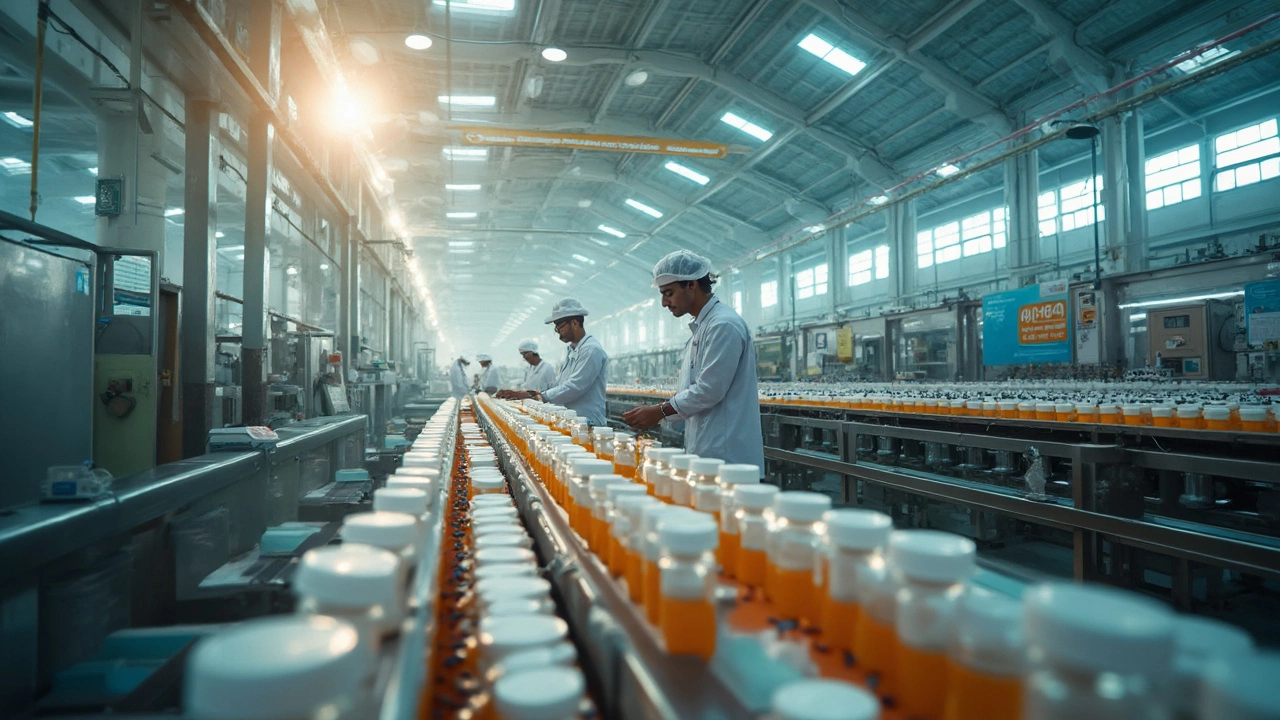Ever notice how your medicine bottle lists "Made in India" somewhere in tiny print? There’s a reason for that. India isn’t just a player in the pharma game—they’re running a huge chunk of it. About 1 in 3 pills taken in the U.S. actually started their journey in India. That’s not a typo.
This isn’t just about cheap labor or big factories. India has a mix of things going for it: an army of trained chemists, factories that stay busy day and night, and a government that cheers them on. They’re not only making loads of generic drugs but also shipping out millions of life-saving medicines to hospitals, pharmacies, and clinics around the world. If you or someone in your family takes prescription meds, chances are you’ve got India to thank for keeping those prices down.
- The Rise of Indian Pharma: A Quick Snapshot
- Why India? Breaking Down the Advantages
- What Makes Indian Medicines So Affordable
- Quality, Safety, and Tips for Consumers
The Rise of Indian Pharma: A Quick Snapshot
The story of pharmaceuticals in India isn’t some old legend. It’s recent. Before the 1970s, India actually imported most of its medicines. But things did a total 180 when the government rolled out new patent laws that let Indian companies make cheaper versions of brand-name drugs—what you probably know as generics.
That move transformed the industry overnight. By the 1990s, Indian firms like Ranbaxy, Sun Pharma, and Dr. Reddy's were cranking out top-quality generic medicines for a fraction of the Western price. The government kept supporting science and pharmacy education, giving the country a steady flow of skilled workers who knew their stuff.
Today, India is famous as “the world’s pharmacy.” Here’s a peek at why it’s such a big deal:
- India now produces over 60% of the world’s vaccines and around 20% of all generic medicines exported globally.
- Nearly 40% of generic drugs sold in the U.S. are made by Indian pharma manufacturers.
- India’s pharma exports hit about $25 billion in the last year alone (2024 data).
Just to put things in perspective, check out this simplified data table:
| Year | Pharma Exports (USD Billion) | Global Rankings |
|---|---|---|
| 2000 | 2.7 | Top 20 |
| 2010 | 10.3 | Top 5 |
| 2024 | 25 | Top 3 |
So if you’ve ever wondered why medicine seems a bit more affordable lately, it’s probably because India had a huge hand in making that possible.
Why India? Breaking Down the Advantages
So, what sets India apart in the world of pharmaceuticals and makes it a go-to hub for making medicines? For starters, India has a huge pool of scientists and chemists—these folks often work for less than a quarter of what their peers earn in the West, without compromising on skills. This means you get solid, affordable talent working behind the scenes to keep drug production moving at full speed.
Factories in India don’t just pop up overnight. The country’s been in this game since the 1970s, and right now, it hosts over 3,000 pharma companies and 10,000 manufacturing sites. Most of these factories follow global safety standards. The FDA (think of them as the medicine police from the U.S.) regularly checks and approves Indian plants. More than 500 Indian factories are FDA-approved, and that’s more than any country outside the U.S.
Another advantage? India’s Patent Act. Back in 1970, this law made it easier and much cheaper to copy (legally) the main ingredients in medicines once their original patents expired. That helped Indian companies rapidly create generic medicine, which is just as good as the brand-name stuff but way more affordable.
Raw materials also play a massive role. India is one of the leading buyers—and lately, even a top producer—of APIs (active pharmaceutical ingredients). These are the main chemicals that make any drug work. With access to these ingredients, Indian pharma manufacturers can churn out everything from painkillers to cancer meds on a massive scale.
There’s also the simple fact that doing business in India is cost-efficient. Electricity, space, and other day-to-day costs are much lower than in the U.S. or Europe. Lower costs = cheaper drug production without cutting corners.
| Fact | India's Standing |
|---|---|
| Share of global generic drugs supplied | About 20% |
| No. of FDA-approved plants outside U.S. | India is #1 |
| Share of U.S. exported medicines from India | Roughly 40% |
Add all this up, and you see why people keep talking about pharma manufacturing in India. It’s smart, efficient, and good for your wallet too.

What Makes Indian Medicines So Affordable
There’s a good reason why pharmacies all over the world stock Indian pharmaceuticals on their shelves—the prices are way lower than what you might expect. This isn’t by accident. India figured out a recipe that cuts costs without cutting corners for both generic and branded drugs.
First off, the major gamechanger: Indian pharma companies mainly make generic medicine. That means after a drug’s patent expires, they jump in and manufacture it without all the research and development bells and whistles the original company paid for. Since they don’t need to sink millions into new drug discoveries, they pass the savings down to you.
Another perk is India’s supply chain. The companies there are pros at keeping costs tight every step of the way. They buy ingredients—often from within India itself—at bulk rates, keep factories running nonstop, and use efficient processes. There’s no extra fluff, just streamlined systems getting medicines out fast and cheap.
- Skilled Workforce: Universities train a steady stream of scientists and chemists, keeping salaries reasonable and expertise high.
- Local Raw Materials: Most active pharmaceutical ingredients (APIs) come from domestic sources, so there’s less need for expensive imports.
- Big Scale, Big Savings: The sheer size of India’s operations lets them make bigger batches, cutting costs even more for customers around the world.
If you like numbers, here’s a peek at why these savings matter. According to Indian government data, Indian-made generics saved the U.S. healthcare system over $20 billion just last year.
| Factor | How It Lowers Cost |
|---|---|
| Generic Focus | No need for expensive R&D |
| Bulk Manufacturing | Cheaper per pill at higher volumes |
| Local Ingredients | Cuts down on import costs |
| Trained Workforce | Skilled people at lower salaries |
This approach lets pharma manufacturers India produce and ship thousands of medicines for a fraction of what they’d cost elsewhere. That’s why, whenever you pick up a prescription, you’re likely getting quality meds at a price your wallet can actually handle.
Quality, Safety, and Tips for Consumers
Let’s talk honestly: a lot of folks raise their eyebrows about quality when they see their prescriptions coming from India. Fair point—trust in your meds is a big deal. But here’s what matters. Indian pharmaceuticals have to follow some strict rules, especially if they want to sell to the U.S., Europe, or Japan. The U.S. FDA checks and inspects Indian pharma manufacturing plants often, and if something’s off, they don’t hold back—companies can get banned from shipping until they fix the problem.
Back in 2023, about 45% of all FDA-approved generic drugs in America came from India. That’s not because of luck, but because Indian factories are properly licensed and government regulators watch closely. Still, slips can happen anywhere. That’s why companies with a sketchy record can’t get away with it for long in the global market. As an official from the U.S. Food and Drug Administration once put it:
“Indian pharma companies making generics for the U.S. face the same inspections and paperwork as those here at home. We expect the same standards everywhere.”
But what can you do as a consumer? Here are a few real-world tips to make sure what you’re taking is safe:
- Check the packaging. Real generic medicine from big Indian exporters should have clear batch numbers and expiry dates. If it looks sketchy or sloppy, ask questions.
- Buy from licensed pharmacies or trusted online stores. Don’t risk it with meds from unknown places or non-accredited websites.
- Look up the manufacturer. Big names like Sun Pharma, Cipla, and Dr. Reddy’s are known worldwide and regularly audited by international agencies.
- Ask your pharmacist if you’re getting an imported product—most don’t mind sharing where your meds were made and how they source them.
- Report side effects. If something feels off after taking any medicine, report it to your doctor or local health authority.
For some extra peace of mind, here’s a quick table showing the most common global checks Indian plants face:
| Regulatory Body | Inspection Frequency | Region |
|---|---|---|
| U.S. FDA | Every 2-3 years | United States |
| European Medicines Agency (EMA) | Every 2-4 years | Europe |
| WHO Prequalification | Varies | Global |
Bottom line: If you’re using pharmaceuticals made in India, you’re not alone—millions do every day. The big names follow the rules, and there’s plenty you can do to double-check that your medicine is safe.






Write a comment